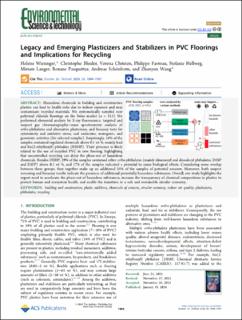Please use this identifier to cite or link to this item:
https://doi.org/10.21256/zhaw-29788Full metadata record
| DC Field | Value | Language |
|---|---|---|
| dc.contributor.author | Wiesinger, Helene | - |
| dc.contributor.author | Bleuler, Christophe | - |
| dc.contributor.author | Christen, Verena | - |
| dc.contributor.author | Favreau, Philippe | - |
| dc.contributor.author | Hellweg, Stefanie | - |
| dc.contributor.author | Langer, Miriam | - |
| dc.contributor.author | Pasquettaz, Roxane | - |
| dc.contributor.author | Schönborn, Andreas | - |
| dc.contributor.author | Wang, Zhanyun | - |
| dc.date.accessioned | 2024-02-02T11:17:08Z | - |
| dc.date.available | 2024-02-02T11:17:08Z | - |
| dc.date.issued | 2024-01-19 | - |
| dc.identifier.issn | 0013-936X | de_CH |
| dc.identifier.issn | 1520-5851 | de_CH |
| dc.identifier.uri | https://digitalcollection.zhaw.ch/handle/11475/29788 | - |
| dc.description.abstract | Hazardous chemicals in building and construction plastics can lead to health risks due to indoor exposure and may contaminate recycled materials. We systematically sampled new polyvinyl chloride floorings on the Swiss market (n = 151). We performed elemental analysis by X-ray fluorescence, targeted and suspect gas chromatography–mass spectrometry analysis of ortho-phthalates and alternative plasticizers, and bioassay tests for cytotoxicity and oxidative stress, and endocrine, mutagenic, and genotoxic activities (for selected samples). Surprisingly, 16% of the samples contained regulated chemicals above 0.1 wt %, mainly lead and bis(2-ethylhexyl) phthalate (DEHP). Their presence is likely related to the use of recycled PVC in new flooring, highlighting that uncontrolled recycling can delay the phase-out of hazardous chemicals. Besides DEHP, 29% of the samples contained other ortho-phthalates (mainly diisononyl and diisodecyl phthalates, DiNP and DiDP) above 0.1 wt %, and 17% of the samples indicated a potential to cause biological effects. Considering some overlap between these groups, they together make up an additional 35% of the samples of potential concern. Moreover, both suspect screening and bioassay results indicate the presence of additional potentially hazardous substances. Overall, our study highlights the urgent need to accelerate the phase-out of hazardous substances, increase the transparency of chemical compositions in plastics to protect human and ecosystem health, and enable the transition to a safe and sustainable circular economy. | de_CH |
| dc.language.iso | en | de_CH |
| dc.publisher | American Chemical Society | de_CH |
| dc.relation.ispartof | Environmental Science & Technology | de_CH |
| dc.rights | https://creativecommons.org/licenses/by/4.0/ | de_CH |
| dc.subject | Building and construction | de_CH |
| dc.subject | Plastic additive | de_CH |
| dc.subject | Chemicals of concern | de_CH |
| dc.subject | Circular economy | de_CH |
| dc.subject | Indoor air quality | de_CH |
| dc.subject | Plasticizer | de_CH |
| dc.subject | Phthalate | de_CH |
| dc.subject | Recycling | de_CH |
| dc.subject.ddc | 363: Umwelt- und Sicherheitsprobleme | de_CH |
| dc.subject.ddc | 660: Technische Chemie | de_CH |
| dc.title | Legacy and emerging plasticizers and stabilizers in PVC floorings : impacts of an industrial transition and recycling | de_CH |
| dc.type | Beitrag in wissenschaftlicher Zeitschrift | de_CH |
| dcterms.type | Text | de_CH |
| zhaw.departement | Life Sciences und Facility Management | de_CH |
| zhaw.organisationalunit | Institut für Umwelt und Natürliche Ressourcen (IUNR) | de_CH |
| dc.identifier.doi | 10.1021/acs.est.3c04851 | de_CH |
| dc.identifier.doi | 10.21256/zhaw-29788 | - |
| zhaw.funding.eu | No | de_CH |
| zhaw.issue | 4 | de_CH |
| zhaw.originated.zhaw | Yes | de_CH |
| zhaw.pages.end | 1907 | de_CH |
| zhaw.pages.start | 1894 | de_CH |
| zhaw.publication.status | publishedVersion | de_CH |
| zhaw.volume | 58 | de_CH |
| zhaw.publication.review | Peer review (Publikation) | de_CH |
| zhaw.webfeed | Ökotechnologie | de_CH |
| zhaw.author.additional | No | de_CH |
| zhaw.display.portrait | Yes | de_CH |
| zhaw.relation.references | https://doi.org/10.17632/s4g2y7c7c7.2 | de_CH |
| Appears in collections: | Publikationen Life Sciences und Facility Management | |
Files in This Item:
| File | Description | Size | Format | |
|---|---|---|---|---|
| 2024_Wiesinger-etal_Legacy-and-emerging-plasticizers-and-stabilizers-in-pvc-floorings.pdf | 2.92 MB | Adobe PDF |  View/Open |
Show simple item record
Wiesinger, H., Bleuler, C., Christen, V., Favreau, P., Hellweg, S., Langer, M., Pasquettaz, R., Schönborn, A., & Wang, Z. (2024). Legacy and emerging plasticizers and stabilizers in PVC floorings : impacts of an industrial transition and recycling. Environmental Science & Technology, 58(4), 1894–1907. https://doi.org/10.1021/acs.est.3c04851
Wiesinger, H. et al. (2024) ‘Legacy and emerging plasticizers and stabilizers in PVC floorings : impacts of an industrial transition and recycling’, Environmental Science & Technology, 58(4), pp. 1894–1907. Available at: https://doi.org/10.1021/acs.est.3c04851.
H. Wiesinger et al., “Legacy and emerging plasticizers and stabilizers in PVC floorings : impacts of an industrial transition and recycling,” Environmental Science & Technology, vol. 58, no. 4, pp. 1894–1907, Jan. 2024, doi: 10.1021/acs.est.3c04851.
WIESINGER, Helene, Christophe BLEULER, Verena CHRISTEN, Philippe FAVREAU, Stefanie HELLWEG, Miriam LANGER, Roxane PASQUETTAZ, Andreas SCHÖNBORN und Zhanyun WANG, 2024. Legacy and emerging plasticizers and stabilizers in PVC floorings : impacts of an industrial transition and recycling. Environmental Science & Technology. 19 Januar 2024. Bd. 58, Nr. 4, S. 1894–1907. DOI 10.1021/acs.est.3c04851
Wiesinger, Helene, Christophe Bleuler, Verena Christen, Philippe Favreau, Stefanie Hellweg, Miriam Langer, Roxane Pasquettaz, Andreas Schönborn, and Zhanyun Wang. 2024. “Legacy and Emerging Plasticizers and Stabilizers in PVC Floorings : Impacts of an Industrial Transition and Recycling.” Environmental Science & Technology 58 (4): 1894–1907. https://doi.org/10.1021/acs.est.3c04851.
Wiesinger, Helene, et al. “Legacy and Emerging Plasticizers and Stabilizers in PVC Floorings : Impacts of an Industrial Transition and Recycling.” Environmental Science & Technology, vol. 58, no. 4, Jan. 2024, pp. 1894–907, https://doi.org/10.1021/acs.est.3c04851.
Items in DSpace are protected by copyright, with all rights reserved, unless otherwise indicated.